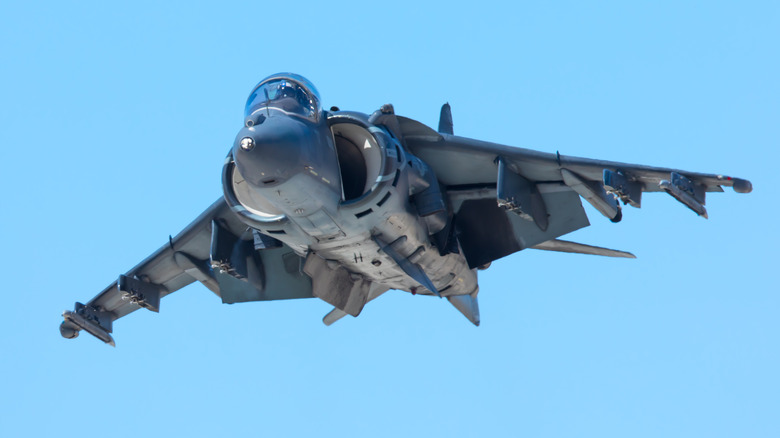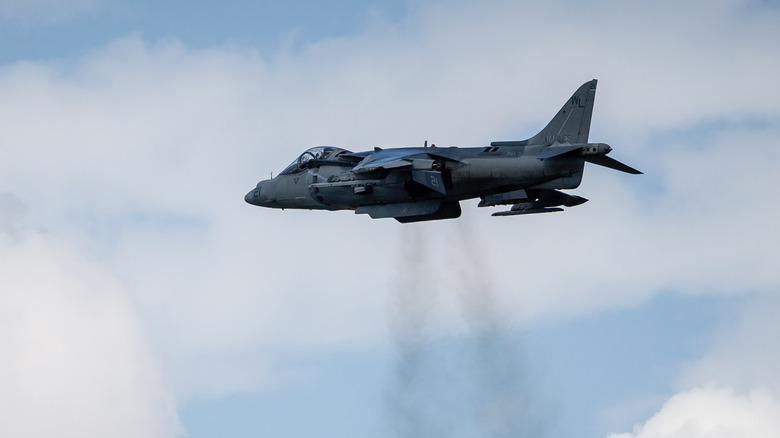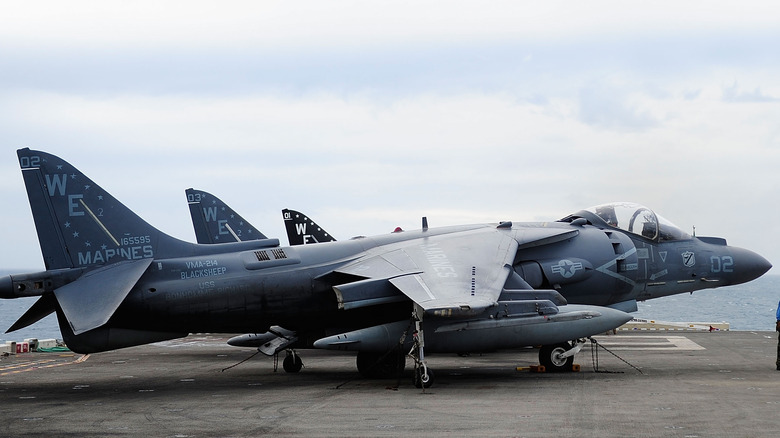Here's What Makes Harrier Jets So Different From Other Jets
If you're not a connoisseur, it can be difficult to distinguish the difference between similar models of TV, smartphone, or vehicle. Take airplanes, for instance. Many couldn't tell a Boeing 747-400 from a 747-8 at a glance, but some aircraft are so distinctive in appearance (such as the Concorde) or in capabilities that there's no mistaking them.
Harrier jets are particularly notable in the latter regard. Jets are a fascinating range of aircraft in general, incorporating many high-speed fighters capable of extraordinary feats. However, they remain airplanes, and so are typically unable to perform the helicopter-esque stunt of hovering in mid-air.
It seems, however, that nobody told the Harrier family of jets this. Their engines are very special compared to those of other airplanes, and that's the key to their success. Here's a look at exactly how helicopters can hover, how Harriers emulate this, and the other traits that make these aircraft so unique.
What do helicopters and Harriers have in common?
In helicopters, hovering is achieved by bringing the aircraft's movement to neutral, maintaining its altitude via the pedals, and making repeated, quick tweaks to prevent it from changing its position. They're essentially always creating their own lift, via the characteristic whirring spin of the rotor blades.
With airplanes, the air's effect on the different surfaces of the wings results in that seemingly impossible force that allows these enormous machines to fly across the globe. With that in mind, the Harrier family sets itself apart with a unique nozzled engine. There are two of these curious structures beneath each wing, and what they allow the pilot to do is switch to generating vertical lift. In this configuration, Harriers have the very rare and famed ability to hover.
This, along with its equally extraordinary ability to pull off VTOL ( vertical takeoff and landing) maneuvers, was a one-of-a-kind trait among airplanes when Hawker Siddleley created the first Harrier in 1969. It was provided by the unique Pegasus engine developed by Rolls-Royce, and the STOV (short take-off and vertical landing) offered by the newest Pegasus 11-61 engine demonstrates that there's still great potential in the technology, despite the fact that it could be rather impractical.
The legacy of the Harrier and the future of VTOL aircraft
Needless to say, an airplane that can hover and land or take off vertically is quite a novelty. It's not just an astonishing trick, either: A military aircraft with these capabilities isn't nearly as vulnerable to the targeting of runways and airports, and so is infinitely more versatile. There were downsides, though. Maneuverability did not mean the Harrier family sacrificed raw power, though: the Harrier II wielded a sophisticated arsenal including Paveway bombs and LAU-5003 rockets, ensuring it could get wherever it needed to go and unleash extraordinary supportive firepower when it got there.
The Harrier couldn't be too hover-happy, because, unsurprisingly, operating in this way was rather costly in terms of fuel. Approximately 170 lbs of fuel are used per minute by a hovering Harrier, and it also has a limited supply of water with which to mitigate the additional stress on the engine. Variants such as the Sea Harrier were introduced, also wielded by the Royal Navy, but by the late 1990s more conventional fighters were outperforming it and advanced versions had stopped serving in that force in the mid-2000s.
This isn't to say, though, that VTOL airplane flight hasn't continued to be pursued and valued. The US, as well as some European forces, look to the F-35B jet variant and its advancements as its successor, a jet with a formidable Pratt & Whitney F135 turbofan that can perform the same feat.


